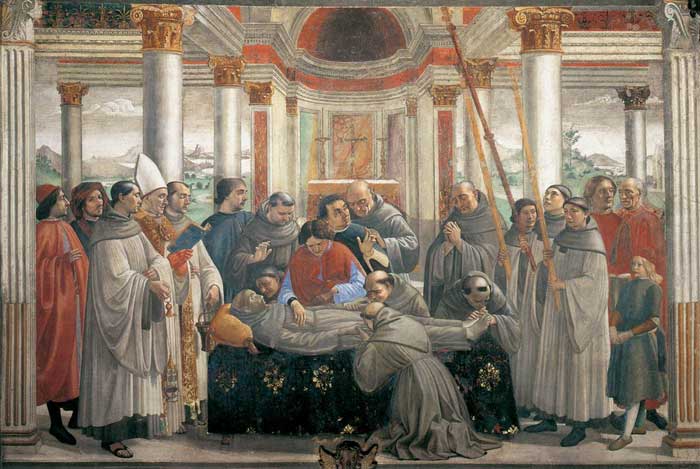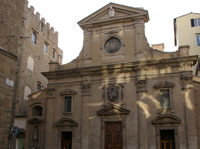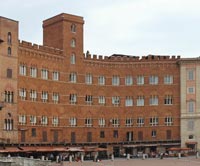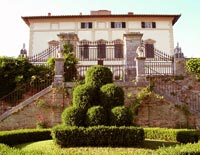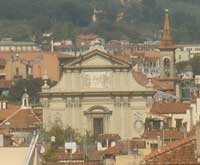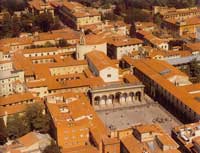
Giorgio Vasari's Lives of the Artists | Domenico Ghirlandaio, painter of Florence
Giorgio Vasari | Le vite de' più eccellenti architetti, pittori, et scultori italiani, da Cimabue insino a' tempi nostri | Domenico Ghirlandaio, Pittore Fiorentino
Art in Tuscany | Domenico Ghirlandaio | Frescoes in Sant'Andrea a Brozzi, San Donnino | The Tornabuoni Chapel | | Portrait of Giovanna degli Albizzi Tornabuoni | The Adoration of the Magi | Domenico Ghirlandaio, The Sassetti Chapel in the Santa Trinita church in Florence | Domenico Ghirlandaio, Calling of the Apostles, 1481, fresco in the Cappella Sistina | Domenice Ghirlandaio, Last Supper frescoes
Domenico Ghirlandaio, original name Domenico di Tommaso Bigordi (born 1449, Florence [Italy]—died Jan. 11, 1494, Florence), early Renaissance painter of the Florentine school noted for his detailed narrative frescoes, which include many portraits of leading citizens in contemporary dress.
Domenico was the son of a goldsmith, and his nickname, “Ghirlandaio,” was derived from his father’s skill in making garlands for the hair of Florentine women. Domenico probably began as an apprentice in his father’s shop, but almost nothing is known about his training as a painter or the beginnings of his career. The earliest works attributed to him, dating from the early 1470s, show strong influences from the frescoes of Andrea del Castagno, who died when Ghirlandaio was about eight years old. The Italian painter, architect, and biographer Giorgio Vasari recorded in his Lives (1550) that Ghirlandaio was a pupil of the Florentine painter Alesso Baldovinetti, even though Baldovinetti was only four or five years older than Ghirlandaio himself. Ghirlandaio preferred to work in fresco on large wall surfaces, but he used smaller-scale paintings executed on wood panels for the altarpieces of the chapels that housed hisfresco cycles. He never experimented with oil painting, although most Florentine painters of his generation began to use it exclusively in the last quarter of the 15th century.
The village church of Cercina, near Florence, has a fresco of three saints, now thought to be Ghirlandaio’s earliest work, but there is general agreement that some frescoes in the Church of Ognissanti in Florence, almost certainly dating from around 1472–73, show his style at its earliest developed stage. One of them, the Pietà, depicts several members of the Vespucci family as mourners, thus already introducing Ghirlandaio’s characteristic combination of portrait figures in contemporary dress with religious subjects. Something of the passion for minute detail shown by the early Flemish painters can be found in Ghirlandaio’s work of this period; hisfresco St. Jerome in His Study (1480), also in Ognissanti, may even be an enlarged version in fresco of an oil painting by the Flemish painter Jan van Eyck, which had found its way to Florence. The St. Jerome fresco is particularly important because it is a companion piece to one of St. Augustine by Ghirlandaio’s Florentine contemporary Sandro Botticelli.
Ghirlandaio’s first major commissioned works were the two frescoes depicting scenes from the life of St. Fina, painted in 1475 in the Chapel of Santa Fina in the Collegiata at San Gimignano, near Florence. Both works derive from Fra Filippo Lippi’s slightly earlier fresco cycle in the cathedral at Prato and contain a number of portrait heads arranged, rather stiffly, in the symmetrical type of composition that was to become increasingly identified with Ghirlandaio. Even then he was already employing assistants; in his later works he clearly could only complete large commissions in the comparatively short time allotted by the extensive use of highly trained assistants working simultaneously on different parts of the frescoes.
The village church of Cercina, near Florence, has a fresco of three saints, now thought to be Ghirlandaio’s earliest work, but there is general agreement that some frescoes in the Church of Ognissanti in Florence, almost certainly dating from around 1472–73, show his style at its earliest developed stage. One of them, the Pietà, depicts several members of the Vespucci family as mourners, thus already introducing Ghirlandaio’s characteristic combination of portrait figures in contemporary dress with religious subjects. Something of the passion for minute detail shown by the early Flemish painters can be found in Ghirlandaio’s work of this period; hisfresco St. Jerome in His Study (1480), also in Ognissanti, may even be an enlarged version in fresco of an oil painting by the Flemish painter Jan van Eyck, which had found its way to Florence. The St. Jerome fresco is particularly important because it is a companion piece to one of St. Augustine by Ghirlandaio’s Florentine contemporary Sandro Botticelli.
Ghirlandaio’s first major commissioned works were the two frescoes depicting scenes from the life of St. Fina, painted in 1475 in the Chapel of Santa Fina in the Collegiata at San Gimignano, near Florence. Both works derive from Fra Filippo Lippi’s slightly earlier fresco cycle in the cathedral at Prato and contain a number of portrait heads arranged, rather stiffly, in the symmetrical type of composition that was to become increasingly identified with Ghirlandaio. Even then he was already employing assistants; in his later works he clearly could only complete large commissions in the comparatively short time allotted by the extensive use of highly trained assistants working simultaneously on different parts of the frescoes.
In 1481–82 Ghirlandaio received an important commission in the Vatican for a fresco, representing the calling of the first Apostles, Peter and Andrew, in the Sistine Chapel. Its style is reminiscent of the frescoes by Masaccio of about 1427, which had been the great innovating works of the early 15th century in Florence. The principal feature of this fresco is the group of portraits of the Florentine colony in Rome, who are represented as witnesses of the biblical event. It has been suggested that the inclusion of these Florentines in afresco painted for the Vatican had political significance, since the Florentine government had recently accused Pope Sixtus IV of complicity in the Pazzi conspiracy. The Pazzi, a powerful Tuscan banking family, had attempted to murder the leading members of the Florentine Medici family, Giuliano and Lorenzo de’Medici (1478). Giuliano had been killed in the attempt while Lorenzo escaped with few wounds.
Ghirlandaio must have used his stay in Rome to study Roman antiquities at first hand, for many details of triumphal arches, ancient sarcophagi, and similar antique elements occur in his works throughout the rest of his career. A sketchbook filled with drawings of such antiquities (now in El Escorial, near Madrid) seems to be the work of a member of his shop.
Late in his short life, Ghirlandaio and his assistants, including his brothers Davide and Benedetto and his brother-in-law Sebastiano Mainardi, produced two majorfresco cycles. The earlier was executed for the Sassetti Chapel in Santa Trinita in Florence. Commissioned by Francesco Sassetti, an agent of the Medici bank, they were painted between about 1482 and 1485. The six main frescoes represent scenes from the life of St. Francis of Assisi, Sassetti’s patron saint. Once more, the frescoes contain many details of the buildings and customs of the period—for example, the Piazza della Signoria with the Loggia dei Lanzi—and, in particular, there are numerous portraits of members of the Sassetti family shown together with some of the leading members of the Medici family, and of leading members of the Florentine mercantile aristocracy. The altarpiece, dated 1485, contains further evidence of Ghirlandaio’s interest in Classical antiquity, for it shows the Adoration of the Shepherds with a Roman triumphal arch in the background and a Roman sarcophagus in place of the traditional manger. This painting in tempera has several direct references to contemporary Flemish paintings, especially the enormous Portinari Altarpiece painted in oil by Hugo van der Goes, which had been commissioned in Flanders by Tommaso Portinari, another agent of the Medici bank, and which arrived in Florence in the late 1470s.
The frescoes in Santa Maria Novella are overcrowded with detail, so that the compositions fail to make their full impact. Some of Ghirlandaio’s smaller panel paintings, particularly the portrait of Giovanna Tornabuoni (1488), have a simplicity that makes them far more striking than the frescoes of Santa Maria Novella. The portrait representing an old man with his grandchild (c. 1480–90) is perhaps Ghirlandaio’s finest painting, notable for its tenderness and humanity, as well as a simplicity and directness of handling.
Ghirlandaio was considered by his contemporaries to be one of the best painters of his generation. In the 19th century, however, the degree of realism in his work was decried by critics, who appreciated him only for his decorative qualities. His work has been reevaluated since the 1960s, and he is now regarded as one of the most eloquent and elegant narrators of Florentine society at the end of the 15th century.
Ghirlandaio’s son, Ridolfo, was also a noted painter and a friend of Vasari. Among his best-known works are a pair representing scenes from the life of St. Zenobius (1517).
[Domenico Ghirlandaio. (2011). In Encyclopædia Britannica. Retrieved from http://www.britannica.com/EBchecked/topic/232731/Domenico-Ghirlandaio]
|
